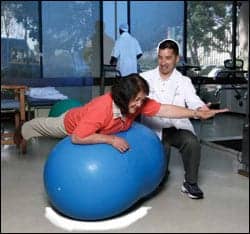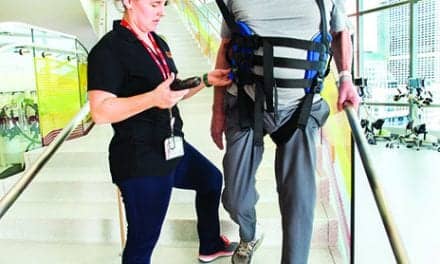 |
| Physical therapist Carl Kubota (right) helps client Cerila A. David with her exercise regimen at Centinela Freeman Regional Medical Center, Los Angeles. |
Go to any rehabilitation trade show, and there will be a candy store of continuous passive motion (CPM) units, trampolines, and elliptical machines from which to choose. Brian Ito, PT and system director of rehabilitation services at the Centinela Campus of Freeman Regional Medical Center, Los Angeles, shares his perspective for choosing the right exercise equipment for his facility and his patients.
The joy of shopping can lend itself to therapists searching for replacements of old exercise equipment or planning for the opening of a new facility. Walking through a trade show, or flipping through catalogs, or even Rehab Management’s product directory, can present an overwhelming smorgasbord of strength and conditioning machines, treadmills, CPMs, and Pilates tables, not to mention low-tech balls, bands, and free weights. But just as one cannot buy the whole candy store, therapists are limited by budgets and space to choose a narrow selection. To pare down the exercise equipment wish list down, therapists can asks one simple question: What do you need?
The answer to that question is naturally going to be different for every facility. However, keeping needs in mind when facing the trade show exercise equipment buffet can help a decision-maker focus on what is truly healthy for the facility, its clinicians, and its clients.
(RE)ASSESS YOUR PATIENT POPULATION
Ito says that one must first consider the existing patient population. The equipment needs of a facility that serves mostly college and high school athletes will not be the same as one that serves a geriatric population, such as Ito’s center. However, Ito points out that a clinic’s needs may change over time.
Ten years ago, Ito’s patient demographic consisted of workers’ compensation and weekend warrior types of injuries. For those requirements, the facility purchased more high-end isokinetic machines. But, instead of finding that trend growing, Ito noted that Centinela Freeman was increasingly serving geriatric patients.
Ito says, “The business does shift. I think the key point is that as clinicians or practitioners, we need to be aware of those shifts in [patient] population so that we can make sure we are always a little bit ahead of the curve, so that we can catch the population as it comes through your doors.”
When making purchases, decision-makers at Centinela Freeman looked at the facility’s clients and determined that many were aging adults and geriatric patients, their equipment needs changed. “All the diagnosis surrounded our geriatric population, so we had to make sure that [much of] our equipment fit their basic, day-to-day needs, such as balance, coordination, strengthening, and range-of-motion [units].”
CONSIDER THE NEEDS OF CLINICIANS AND PHYSICIANS
At the same time that the predominant patient population is identified, a facility’s main referring physicians will be revealed. One way to maintain and perhaps improve those very important referral relationships is to spend 5 minutes with key referring physicians and ask their opinions about what new equipment they would like to see in the facility. These ideas may be taken into consideration within the budget, but if managers hear the same request repeatedly, then it would be prudent to seriously research and consider these suggestions.
Similarly, Ito says that his own staff clinicians influence the decisions for purchasing the larger equipment. Because of the PT shortage in many areas of the country, Ito believes that consulting with a facility’s clinicians is one way to help with staff retention as well as to meet the facility’s needs.
“Retention is a key factor for managers,” Ito says. “My main obligation is to provide education for my clinicians as well as equipment to help them do their best job. I rely on them to let me know what they need and to guide me to be effective in those decision-making processes. This goes hand in hand with [staff] retention. It’s not easy—it’s a balancing act of what we can afford and what we need to buy for them.”
Clinician exercise equipment suggestions are not made lightly. Ito says that the requests are made based on a number of factors, including information found at conferences, visiting other clinics, or a clinician’s previous experience at former clinics.
In addition, Ito and his staff research potential products. He says, “By all means, we want to make sure what we’re doing is evidence based, and that it’s not hearsay or something that was just customary in the past.” This research includes not only talking with colleagues, but also reading medical journals.
Hiring recent graduates can also lend insight into cutting-edge therapy products. “When kids come out of school, they are always being given the latest pieces of research,” Ito says. “As clinicians, we always stay abreast of the newest pieces and projects that are out [in the market] so that we can deliver the best care to our patients.”
Another part of Ito’s research is being able to test the
equipment. When he or one of his colleagues is interested in a piece of equipment, Ito will contact the vendor to see if he can obtain an on-site trial before purchasing. When this is not possible, vendors may recommend nearby clinics where the equipment is being used, so that Ito and his staff can arrange a time to observe the equipment in action and do further research.
MACHINES VERSUS MANUAL
Deciding whether to go low-tech or high-tech can depend on budget, space, and the patient population, as well as the impression being conveyed to patients as they walk into the clinic area. CPM machines and isokinetic equipment may be a mainstay for some centers, but for others, these pieces may be less important than basic gear, such as dumbbells and pulley systems.
For example, as a facility that has an aging clientele, Centinela Freeman relies less on technology and more on basic exercise equipment that older patients can easily purchase and practice exercises to use on their own. These items include bands, balls, balance boards, free weights, and ankle weights. That is not to say, however, that Ito does not make use of more sophisticated rehabilitation machines.
He says, “We use isokinetic equipment, of course. The benefit of that is that you can actually see printouts and look at the actual torque curves and analyze them, and to be able to do more specific training for those muscles.”
Though cutting-edge equipment has its uses, Ito believes that the low-tech equipment allows more contact with patients and therefore leads to better therapy compliance. He explains, “Some patients may be impressed by equipment, but I think the patients that really are satisfied most are those patients that are being touched by their therapists.”
Ito attributes this preference for more hands-on therapy to the center’s analysis of patient attendance patterns. They discovered that when therapists are physically involved with manually manipulating their patients, there are fewer canceled appointments than for patients who spend much of their therapy time on various pieces of equipment. He says, “It’s actually placing your hands on your patient, doing the mobilization, the muscle re-education, guiding them with your hands on firing patterns with muscles, the manual strengthening exercises. That’s the basic thing of showing that you care.”
At the same time, Ito recognizes that therapists cannot always handle every situation with hands and bands. He says, “If you’re working with a 300-pound athlete, there’s no way that a 110-pound therapist will be able to give them that manual resistance that they would need. In those cases, machines are essential for the client—and for lowering wear and tear on your therapist, too.”
High-tech equipment choices can be beneficial as transition pieces as well, Ito continues. “Once we get the patients to where they can start doing some exercise on their own, it’s good to start bringing them some transitional types of equipment, like bikes, or ellipticals or stair machines, so that they can continue [exercising] at their local gym.”
Sophisticated equipment may also be very important for the image of a sports rehabilitation and training center. Even if therapists do not directly work with these machines, clients may judge the facility based on its row of new treadmills and recumbent bicycles that integrate a television or a virtual race course while measuring distance, cadence, heart rate, and calories burned. Moreover, the same bells and whistles may provide motivation for those clients trying to reach daily milestones or who prefer a variety of workouts.
THE BASICS
Since every rehabilitation center will have a different referral base, finances, and space, there is no single must-have equipment list for every center. However, Ito recommends a few general pieces that are versatile and will not break the budget or space considerations. These include:
- Therapeutic bands;
- Swiss balls;
- Cuff weights;
- Therapy wedges;
- Mats;
- Balance boards;
- Treadmills;
- Pulleys;
- Bicycles, elliptical and stair machines for transitional equipment;
- Multicenter gyms with a small footprint that have exercises for both upper and lower extremities; or
- Ultrasound and electric stimulation machines for pain-reducing modalities.
THE MOST IMPORTANT EQUIPMENT
In the end, Ito believes that the most important pieces of equipment in a facility are truly the therapists themselves. He advises facility managers to be sure that they have the right clinicians for the right population. “There are clinicians who want to specialize in sports medicine,” Ito says. “If you’re a geriatric clinic, that’s not really the best pairing or matching. So that’s probably the most important equipment. I hate to say that weird word ‘equipment,’ but that’s really the pivotal part.”
Having the right therapist also enables facilities to make the most of the equipment. Referring to low-technology equipment, Ito says, “The key is having therapists who are imaginative enough to use some low-tech equipment to do some really great work. You would be surprised with the type of work you can do with a Swiss ball. They are pretty rigorous. You are only limited by your lack of imagination.”
Tor Valenza is a staff writer for Rehab Management. For more information, contact





